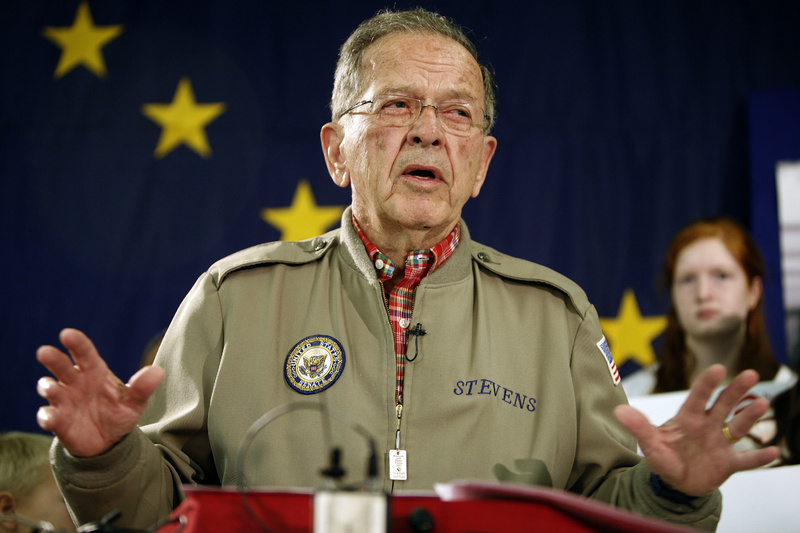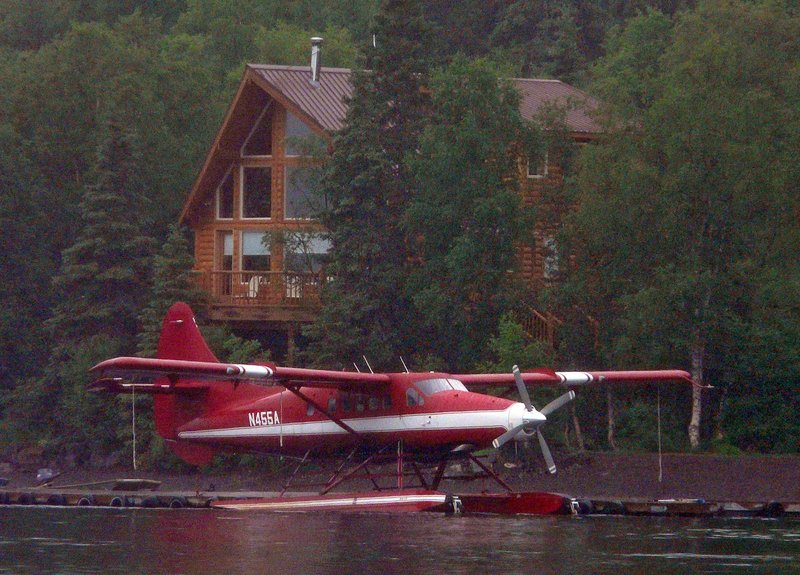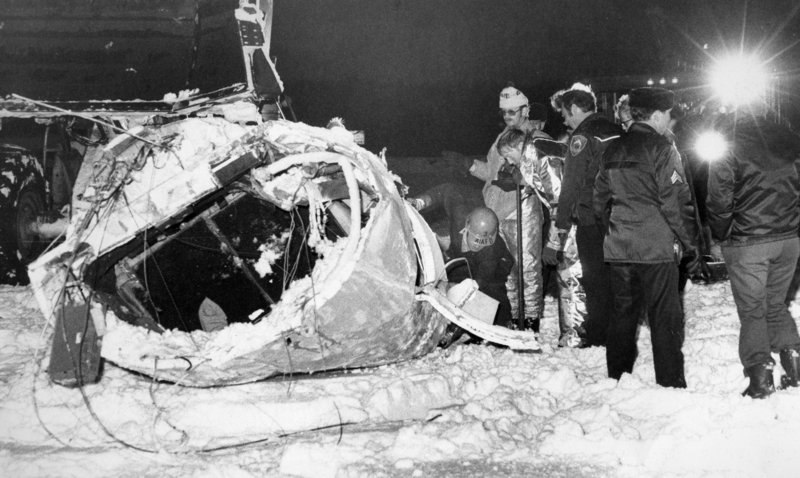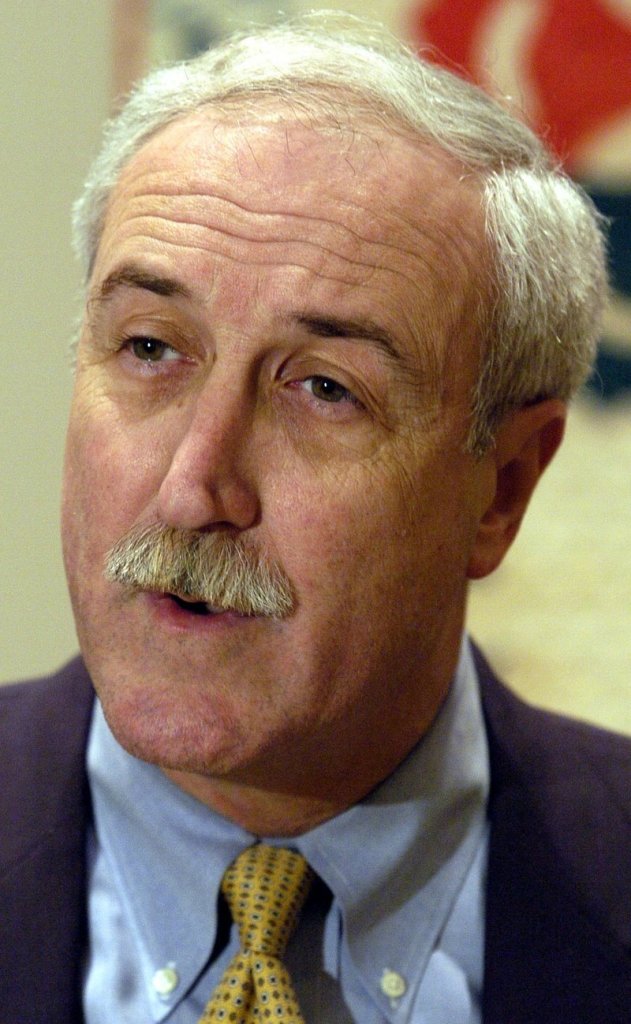DILLINGHAM, Alaska — An amphibious plane carrying former Sen. Ted Stevens crashed into a remote mountainside during a fishing trip, killing the state’s most beloved political figure and four others and stranding the survivors on a rocky, brush-covered slope overnight.
Three teenagers and their parents, including the former head of NASA, were on the plane when it plowed into the mountain Monday afternoon with so much force that it left a 300-foot gash on the slope, federal investigators said.
A doctor and two EMTs hiked to the scene Monday evening and tended to the survivors’ broken bones and other injuries during a frightening night on the mountain until rescue teams could arrive Tuesday morning.
A 13-year-old boy survived but had to spend the night near his dead father and the senator. A mother and her 16-year-old son died. Former NASA chief Sean O’Keefe survived along with his teenage son.
The 86-year-old Stevens’ death stunned lawmakers and residents alike because of his pre-eminence in Alaska history: A decorated World War II pilot who survived a deadly 1978 plane crash, he was the longest-serving GOP senator in history and became the patron saint of Alaska politics as he brought billions of federal dollars home.
One failed effort – the infamous “Bridge to Nowhere” – became part of his national legacy, as did corruption convictions that helped foil his 2008 campaign after 40 years in office. The case was later tossed out.
“He is one of the real giants,” said Paul Brown, a consultant who was having lunch at an outdoor cafe in Anchorage. “He dedicated his life to this state.”
Investigators with the NTSB arrived late Tuesday at the crash site outside Dillingham, located on Bristol Bay about 325 miles southwest of Anchorage. The cause was not immediately known, but weather is one area investigators will examine.
The flights at Dillingham are often perilous through the mountains, even in good weather. NTSB chairwoman Deborah Hersman said weather conditions at the time of the accident included light rain, clouds and gusty winds.
Hersman said the group had eaten lunch at a lodge and boarded a 1957 red-and-white float plane between 3 p.m. and 3:15 p.m. local time for a trip to a salmon fishing camp. The FAA had previously said the plane took off between 1 p.m. and 2 p.m.
Lodge operators called the fish camp at 6 p.m. to inquire when the party would be returning for dinner, but were told that they never showed up. Civilian aircraft were dispatched, and pilots quickly spotted the wreckage a few miles from the lodge, Hersman said.
The doctor and EMTs were flown to the area and hiked to the wreckage as fog and rain blanketed the area and nightfall set in, making it impossible for rescue officials to reach the scene until daybreak.
The Federal Aviation Administration said the 1957 de Havilland DHC-3T was registered to Anchorage-based General Communications Inc., a phone and Internet company.
Four survivors were taken to Providence Hospital in Anchorage with “varying degrees of injuries,” Alaska State Troopers said. Former NASA spokesman Glenn Mahone said O’Keefe, 54, and his son had broken bones and other injuries.
Sean O’Keefe was listed in critical condition late Tuesday afternoon, while son Kevin was listed in serious condition and sleeping. “There’s no way he can talk in his condition,” Providence Hospital spokesman John Hogue said of the younger O’Keefe.
The other survivors were William “Willy” Phillips Jr., 13; and Jim Morhard, of Alexandria, Va.
The victims were identified as Stevens; pilot Theron “Terry” Smith, 62, of Eagle River; William “Bill” Phillips Sr.; Dana Tindall, 48, an executive with GCI; and her 16-year-old child Corey Tindall.
Megan Peters, a spokeswoman for the troopers, said that the bodies have been recovered and were being taken to Anchorage.
Stevens and O’Keefe were fishing companions and longtime Washington colleagues who worked together on the Senate Appropriations Committee that the Republican lawmaker led for several years. Stevens became a protege to the younger O’Keefe and they remained close friends over the years.
Plane crashes in Alaska are somewhat common because of the treacherous weather and mountainous terrain. Many parts of the state are not accessible by roads, forcing people to travel by air to reach their destinations.
Stevens was one of two survivors in a 1978 plane crash at Anchorage International Airport that killed his wife, Ann, and several others.
In a similar accident by another GCI-owned plane, an amphibious, float-equipped de Havilland plane flipped after landing on Lake Nerka in 2002. The pilot drowned and a passenger was injured. The plane was landing on the lake in front of the lodge when the accident occurred.
Alaska Sen. Lisa Murkowski said the state had lost a hero and “I lost a dear friend,” praising his service during World War II. He flew cargo planes over “the hump” in the Himalayas and was awarded the Distinguished Flying Cross.
“Alaska has lost one of its greatest statesmen and a true pioneer of our state with the passing of Senator Ted Stevens,” said Murkowski’s counterpart, Mark Begich, who defeated Stevens in 2008 and who lost his politician father in a plane crash in 1972.
A White House spokesman said President Barack Obama called Stevens’ widow, Catherine, on Tuesday afternoon to express his condolences.
“A decorated World War II veteran, Sen. Ted Stevens devoted his career to serving the people of Alaska and fighting for our men and women in uniform,” Obama said in prepared remarks.
Stevens was appointed in December 1968 and became the longest-serving Republican in Senate history. (The late Strom Thurmond was in the Senate longer than Stevens, but he spent a decade there as a Democrat before switching to the GOP.)
“He always kept his word to me and to other senators,” said Sen. Patrick Leahy, D-Vt.
The wiry octogenarian was a legend in his home state, where he was known as “Uncle Ted.” Though he was built like a birch sapling, he liked to encourage comparisons with the Incredible Hulk — an analogy that seemed appropriate for his outsized place in Alaska history.
He was named Alaskan of the Century in 1999 for having the greatest impact on the state in 100 years. He brought in “Stevens money” that literally helped keep the remote state solvent. The Anchorage airport is also named in his honor.
“He did his job and he did it well,” said Royce Metz, a bookstore worker. “That’s all I want to know about a politician: Do your job.”
But one of his projects — infamously known as the “Bridge to Nowhere” — became a symbol of pork-barrel spending in Congress and a target of taxpayer groups who challenged an appropriation for hundreds of millions of dollars for bridge construction in Ketchikan.
Stevens’ standing in Alaska was toppled by corruption allegations and a federal trial in 2008. He was convicted of all seven counts – and narrowly lost to Begich in the election the following week. But five months later, Attorney General Eric Holder dropped the indictment and declined to proceed with a new trial because of prosecutorial misconduct.
Stevens never discussed the events publicly.
Copy the Story Link
Send questions/comments to the editors.






Success. Please wait for the page to reload. If the page does not reload within 5 seconds, please refresh the page.
Enter your email and password to access comments.
Hi, to comment on stories you must . This profile is in addition to your subscription and website login.
Already have a commenting profile? .
Invalid username/password.
Please check your email to confirm and complete your registration.
Only subscribers are eligible to post comments. Please subscribe or login first for digital access. Here’s why.
Use the form below to reset your password. When you've submitted your account email, we will send an email with a reset code.